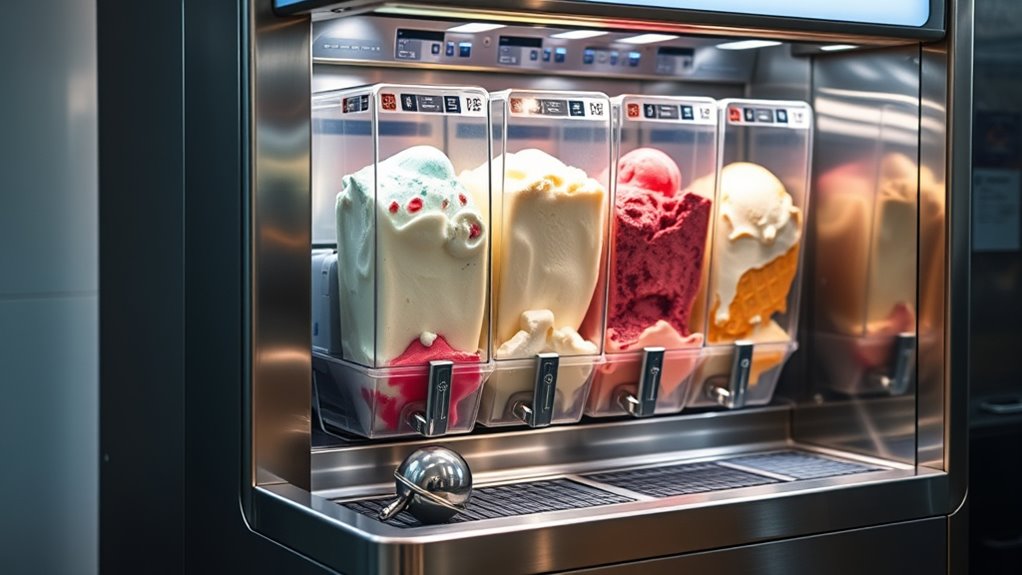If you’re exploring commercial ice cream machines, you’ll want to understand the different types, like soft-serve, batch freezers, and gelato machines, to match your business needs. Consider key features such as capacity, ease of use, and maintenance requirements to guarantee efficiency. Budgeting for upfront costs and ongoing expenses is also important for profitability. Plus, proper ventilation and safety practices keep your operation running smoothly and safely. Keep exploring to discover more tips and insights.
Key Takeaways
- Understand different types of commercial ice cream machines (soft-serve, batch freezers, gelato) and their ideal business applications.
- Regularly maintain and troubleshoot equipment to ensure optimal performance, hygiene, and longevity.
- Budget for initial costs, ongoing expenses, and safety measures, including proper serving practices and staff training.
- Ensure proper ventilation to improve air quality, prevent health risks, and enhance equipment efficiency.
- Choose features like capacity, adjustable settings, and accessories aligned with your volume, flavor variety, and business needs.
Types of Commercial Ice Cream Machines and How They Work
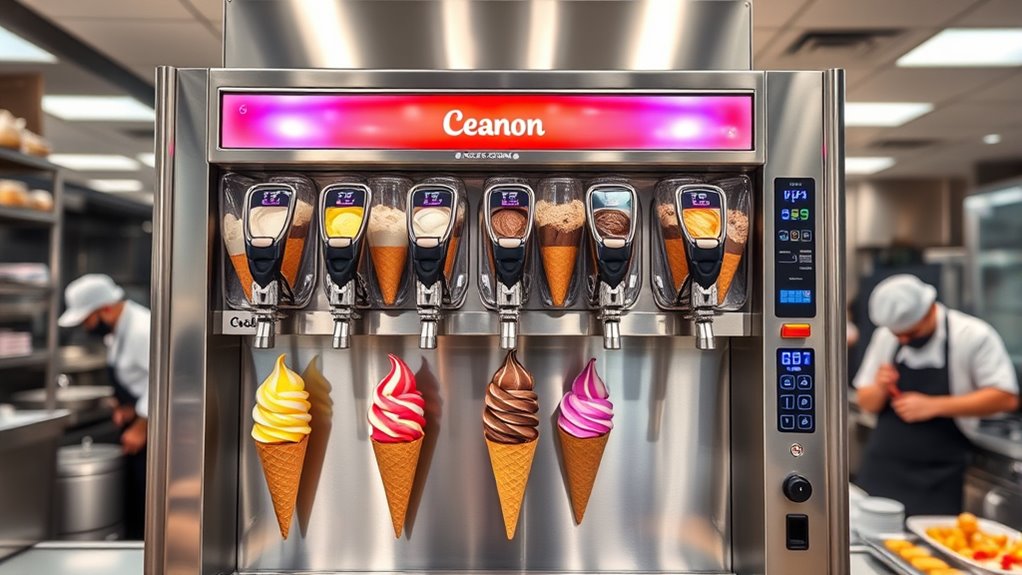
There are several types of commercial ice cream machines, each designed to meet different business needs. One common type is the soft-serve machine, which offers quick flavor customization and a consistent texture. These machines typically have a smaller storage capacity, meaning you serve fresh batches regularly. On the other hand, batch freezers produce larger quantities of ice cream at once, making them ideal for high-volume settings; they often feature greater storage capacity and allow for more flavor variety. Another option is the gelato machine, which emphasizes dense, rich textures and offers precise control over flavor customization. Understanding how each machine works helps you choose the right one for your business, balancing flavor options with storage capacity to meet customer demand efficiently.
Key Features to Consider When Choosing an Ice Cream Machine
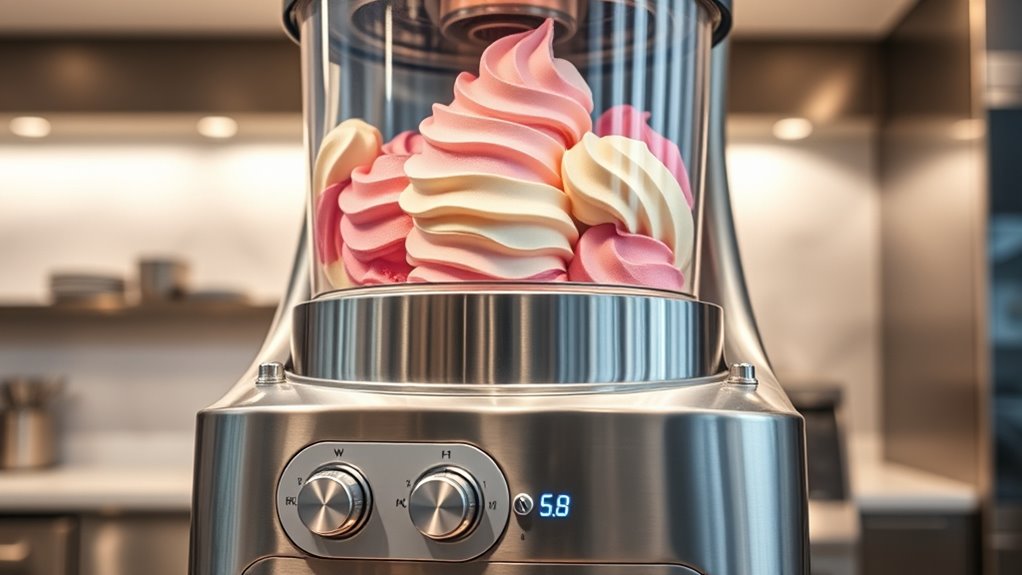
When selecting an ice cream machine for your business, focusing on key features guarantees you find the right fit for your needs. First, consider the machine’s capacity to handle the variety of ice cream flavors you want to offer, ensuring it meets your customer demand. Look for adjustable settings that control texture and temperature, which affect ice cream quality. Machine accessories, like dispensing handles, mixing paddles, and cleaning tools, can streamline operations and maintenance. Ease of use is essential, so choose a machine with simple controls and clear indicators. Durability matters too; opt for sturdy materials that withstand daily use. Additionally, incorporating vertical storage solutions can help organize your ingredients and supplies for efficient workflow. Proper maintenance practices are crucial for prolonging the lifespan of your equipment and ensuring consistent product quality. By evaluating these features, you’ll select a reliable machine that produces high-quality ice cream consistently and supports your business growth.
Proper Maintenance and Troubleshooting Tips
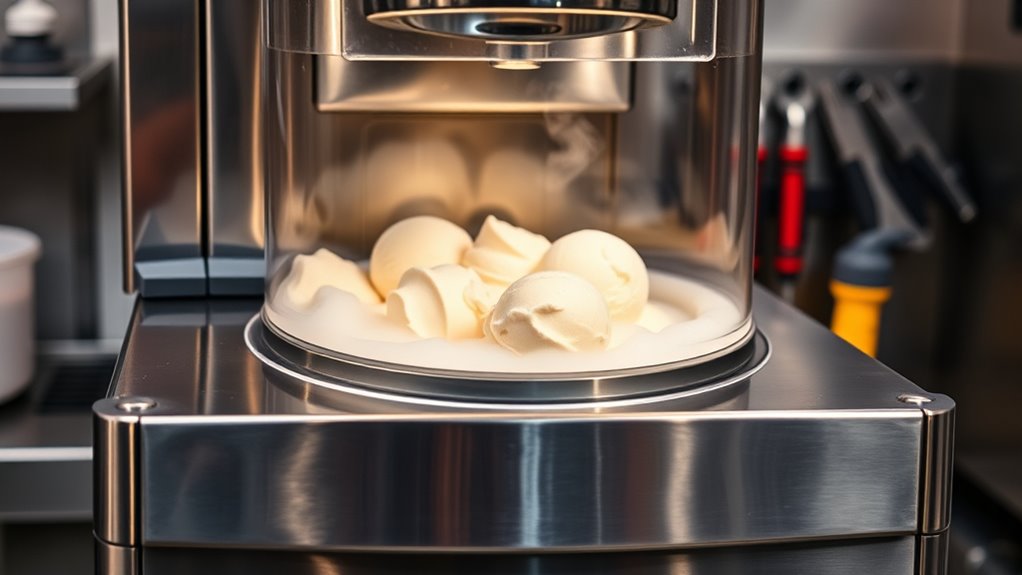
Maintaining your commercial ice cream machine properly is crucial to guarantee it operates efficiently and produces high-quality products. Regular cleaning routines prevent buildup and bacteria, extending your machine’s lifespan. When troubleshooting common issues, start by checking the power supply and ensuring all connections are secure. Keep an eye on the consistency of the mixture and temperature settings to avoid inconsistency in your ice cream. Here are some tips to help:
Regular maintenance and inspections are key to keeping your ice cream machine efficient and producing top-quality treats.
- Follow a consistent cleaning routine to prevent mold and residue.
- Inspect seals and gaskets for wear and replace as needed.
- Clear any blockages in the dispensing system.
- Monitor temperature and ensure proper calibration.
- Regularly check for leaks or unusual noises.
- Incorporating proper hygiene practices in your maintenance routine can further prevent contamination and ensure safety. Additionally, understanding Ford Tuning principles can help you optimize your equipment’s performance and longevity. Regularly inspecting electrical components and understanding their diagnostic signals can also aid in early detection of potential issues, reducing downtime. Implementing preventive maintenance strategies can help identify issues before they become costly repairs, ensuring your equipment remains in prime condition. Performing routine inspections can help catch minor problems early, saving time and money in the long run. Proper maintenance minimizes downtime and helps you quickly resolve issues, keeping your business running smoothly.
Cost Factors and Budgeting for Your Ice Cream Equipment
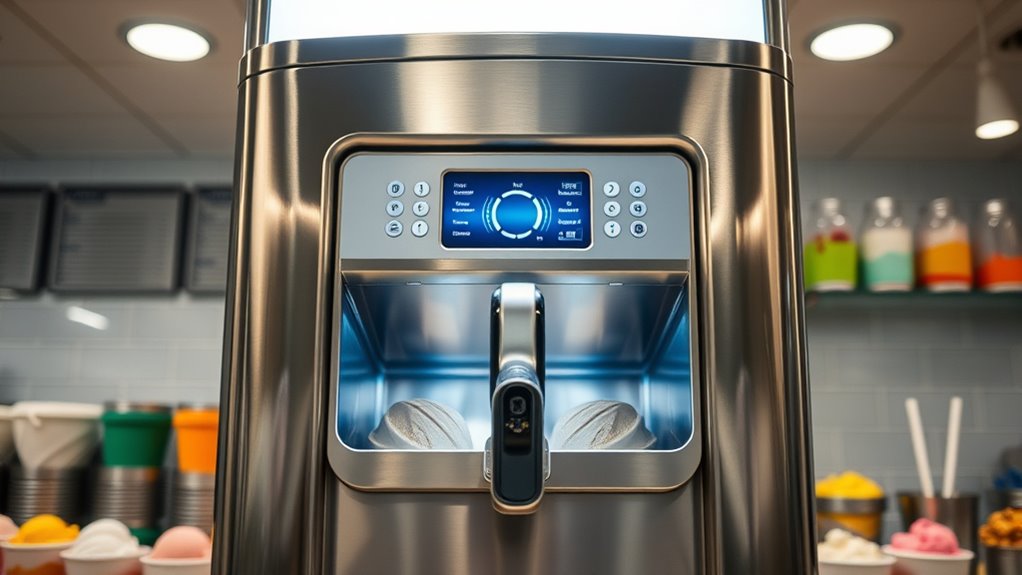
Understanding the cost factors involved in purchasing and maintaining commercial ice cream equipment is essential for creating an effective budget. Your expenses include initial purchase prices, ongoing maintenance, and energy costs. To manage these, consider different pricing strategies such as leasing or buying outright, which can affect your cash flow. Equipment financing options can help spread out costs, making high-quality machines more accessible. Here’s a breakdown of typical costs:
| Cost Aspect | Description | Estimated Range |
|---|---|---|
| Equipment Purchase | Cost of machine | $3,000 – $10,000 |
| Installation & Setup | Initial setup and calibration | $500 – $2,000 |
| Maintenance & Repairs | Upkeep to ensure longevity | $300 – $1,000/year |
| Energy Consumption | Power costs for operation | $200 – $600/year |
| Upgrades & Accessories | Additional features or parts | $200 – $1,000 |
Evaluating these factors helps you develop a realistic budget aligned with your financial strategy. Additionally, considering the cost of energy consumption can significantly impact your ongoing expenses. Properly assessing initial purchase costs and ongoing expenses ensures sustainable operation and profitability. Regular maintenance and understanding long-term costs are crucial for maximizing your equipment’s lifespan and performance. Being aware of regulatory compliance requirements for your equipment can also prevent costly penalties or modifications in the future. Moreover, factoring in market demand can influence your purchasing decisions and pricing strategies.
Best Practices for Serving and Operating Safely
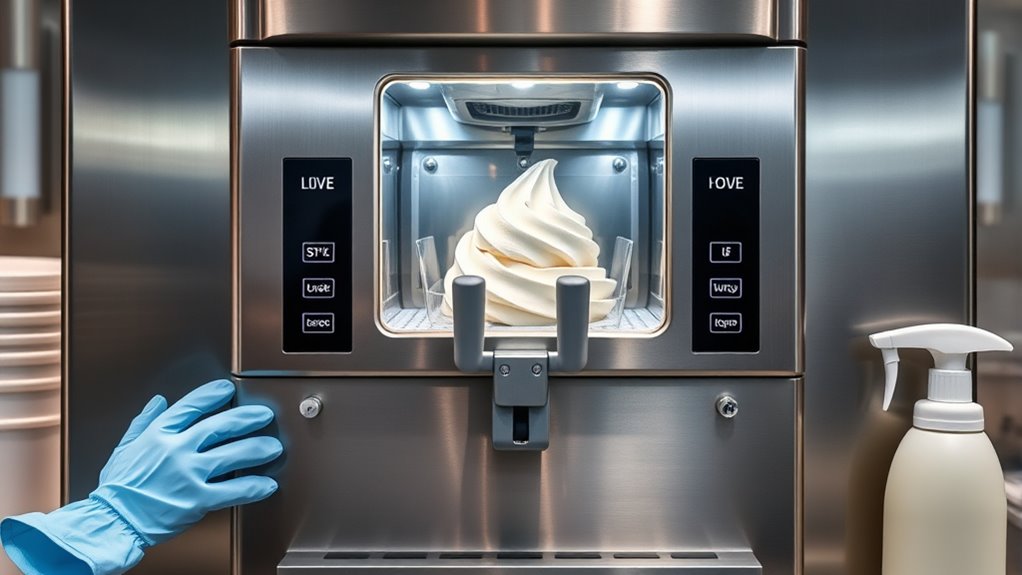
To serve ice cream safely and maintain high hygiene standards, you need to follow best practices consistently. Proper hygienic handling prevents contamination, while effective temperature control ensures product quality and safety. Always wash your hands thoroughly before serving and use clean utensils. Keep the ice cream at the recommended temperature to prevent bacteria growth. Regularly sanitize all equipment and surfaces to avoid cross-contamination. Monitor the temperature gauges closely and adjust as needed. Avoid leaving the machine unattended with open lids or exposed product. Use gloves when handling ice cream and avoid touching the serving area directly. Educate staff on hygiene protocols and proper operating procedures. Maintaining a clean environment is crucial, and understanding the importance of proper disposal practices helps prevent equipment clogs and contamination. Regularly checking the filter performance and replacing filters when necessary can help maintain optimal cleanliness and efficiency. Additionally, staying informed about AI detection methods can help ensure compliance with safety standards. Maintaining consistent temperature control throughout the day is vital for product safety and quality. Practice hygienic handling at all times. Regularly clean and sanitize equipment. Use appropriate protective gear. Monitor and document hygiene practices. A thorough understanding of local health regulations will further ensure compliance and safety in your operations. Incorporating proper ventilation can also reduce the accumulation of airborne contaminants in the workspace.
Frequently Asked Questions
What Are the Environmental Impacts of Different Ice Cream Machine Types?
When considering the environmental impacts of different ice cream machines, you should look at energy consumption and waste management. Some machines use more energy, increasing your carbon footprint, while others are energy-efficient. Waste management is also vital; machines that produce excess packaging or leftover product contribute to landfill waste. Choosing eco-friendly, energy-efficient models helps reduce environmental impact, making your operations greener and more sustainable.
How Do I Train Staff to Operate the Ice Cream Machine Safely?
To train staff to operate the ice cream machine safely, you should start with thorough staff training focused on safety procedures. Show them how to properly operate and clean the machine, emphasizing safety protocols and potential hazards. Practice hands-on demonstrations and review safety guidelines regularly. make certain they understand emergency shutdown procedures and proper hygiene. Consistent training keeps staff confident and prevents accidents, ensuring smooth, safe operation of the ice cream machine.
Are There Warranty Options for Commercial Ice Cream Machines?
Think of warranty options as a safety net for your ice cream machine journey. You can secure warranty coverage that shields you from unexpected repair costs, and many providers offer service plans tailored to keep your machine running smoothly. These plans act like a trusty pit crew, ready to jump in and fix issues swiftly, ensuring your operation stays sweet and uninterrupted. Always explore your options to keep your investment protected.
Can I Use These Machines for Non-Dairy or Allergen-Free Products?
You can definitely use commercial ice cream machines for non-dairy or allergen-free products, but you need to take into account the machine’s design and cleaning process. Dairy alternatives like almond, soy, or coconut milk require thorough cleaning to avoid cross-contact. Check for allergen considerations and ensure the machine is compatible with these ingredients. Proper maintenance prevents contamination and guarantees safe, delicious results for all dietary needs.
What Are the Legal Regulations for Commercial Ice Cream Equipment?
You need to understand licensing requirements and health code compliance when using commercial ice cream equipment. Regulations vary by location, so you should check local health departments for specific rules. Typically, you must obtain permits, guarantee your machine meets sanitation standards, and follow proper maintenance procedures. Staying compliant not only helps avoid fines but also ensures your products are safe for customers, maintaining your business’s reputation.
Conclusion
Choosing the right commercial ice cream machine is like finding the perfect recipe—it takes understanding, care, and a dash of patience. By knowing the types, features, and maintenance tips, you’re well on your way to serving delicious treats safely and efficiently. Keep your equipment in top shape, budget wisely, and always follow best practices. With these tools in hand, you’ll turn your ice cream dreams into a sweet, smooth reality that keeps customers coming back for more.
